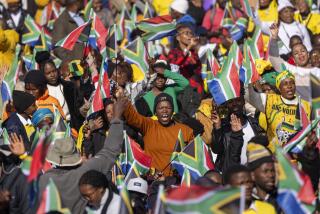News Background : Language Issue Sparked 1976 Soweto Clash
- Share via
Soweto’s role as a symbol of the struggle of black South Africans began 10 years ago with deceptive innocence.
Hundreds of black schoolchildren met at a community center in the sprawling black township southwest of Johannesburg and agreed to stage a protest three days later against the requirement that half their education be conducted in Afrikaans, the language of the ruling white minority, the other half in English, which the students preferred. The “language of the oppressor,” they called it as they organized for the protest.
Language was the immediate issue, but crowded “matchbox” housing, a lack of electricity and other complaints flowing from the apartheid system had led to smoldering discontent in Soweto, with its population of over 1 million swelled by immigrants to the Johannesburg area in the boom period during and after World War II.
On June 16, 1976, a cold winter day in the Southern Hemisphere, thousands of black schoolchildren from throughout Soweto converged and marched toward a school atop a hill to support pupils there who had been boycotting classes for five weeks to protest the order to use Afrikaans.
Witnesses said police told the students to disperse, and the students taunted the police and threw rocks. The police used tear gas to try to break up the demonstration. But as a police official said afterward: “. . . In the open, tear gas was not very successful. The police then fired warning shots and this stopped the crowds for a while. But then they came on again.”
A black reporter on the scene said a white policeman fired his revolver. Other policemen then began shooting.
Hector Petersen, 13, a pupil at Morris Isaacson High School, fell to the ground, bleeding from the ears and mouth, the first victim of what was to be an 11-month period of intermittent nationwide violence. The widely published photo of Petersen being carried away by another youth while his sister ran screaming beside him remains the day’s starkest image.
Within hours, shops, schools and government buildings were burning throughout Soweto, and hard-pressed police called for reinforcements as thousands of rioters roamed the streets. Among the casualties were two white motorists dragged from their cars and stoned to death.
Rioting quickly spread to other black ghettos around Johannesburg, and more than 1,500 people were arrested. The death toll in repeated clashes between blacks and security forces mounted into the hundreds.
Spreading to the scores of black townships across the country, the disorder shifted from protest at what blacks considered inferior education for black youngsters to general opposition to white rule.
When the violence finally subsided the next April, an official inquiry put the death toll at 575. Of those, 451 were listed as killed by police. Unofficial sources put the number of deaths at more than 1,000. The official commission said that 3,907 had been injured, 2,389 by the security forces.
Nearly 6,000 people were arrested during the months of violence for offenses related to the uprising. Hundreds were detained without trial.
Many black students left the country during the months of disorder, some of them joining the outlawed African National Congress, based in neighboring Zambia. The Soweto uprising had contributed its share to the movement challenging apartheid and the white minority government.
More to Read
Sign up for Essential California
The most important California stories and recommendations in your inbox every morning.
You may occasionally receive promotional content from the Los Angeles Times.













